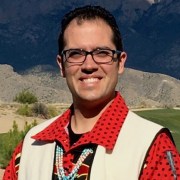Artist Statements
 Lee Francis 4
Lee Francis 4
In 2017, a fella by the name of Will Fenton contacted me about a new comic book project he was working on with the Library Company of Philadelphia. I tend to get emails like this very often but what piqued my interest was that he said he wanted to meet in person at our Indigenous Comic Con that fall.
So in November 2017, I met with Will to discuss the project. Hearing about Will’s work with Digital Paxton and his desire to tell the story of the Conestoga People was energizing. But I was still hesitant. As a Native writer, I am often called in to consult on projects that engage Native subject matter.
But Will had an incredible plan, one that was about collaboration and including Native creatives, Native communities, and Native history in an Indigenized process.
Working on this project has been an experience like no other. Beginning with another chance to work with the exceptional Weshoyot Alvitre to meeting the Native community (Circle Legacy) in Lancaster, Pennsylvania to hanging with comic book legend, Timothy Truman, as we toured the locations of the Conestoga People in central Pennsylvania. Moreover, it was the spirit of this work that has been refreshing and powerful.
As the writer on Ghost River, my job is to give voice to those who were silenced. The delicate task of balancing a tragic story with the resilience of a People has been complex and rewarding. Most importantly, the opportunity to fill in the gaps of the Western historical narrative through word and illustration aligns with my ongoing work of creating positive and dynamic representations of Native People.
Ghost River should serve as a model of how to work in and with Native communities. I am honored to be a part of this project and so grateful that Will reached out to begin this important work.
Da’wah’eh (Thank You)!
 Weshoyot Alvitre
Weshoyot Alvitre
My work on Ghost River: The Fall and Rise of the Conestoga is intended to shed light on a dark corner of early American history by giving a voice to those who have been silenced by colonialism and the patriotic propaganda of history as we know it.
For this particular project, I chose to use traditional art medium of antique dip pen and ink, with earth-based pigment watercolors handmade by THE PIGMENT HUNTER. My intention was to mimic the original political cartoons we viewed at The Library Company and to reclaim that period with fresh representational art of the Native Americans who lived and died during this period of history. My intent in using earth pigment paints was to tie this artwork to the land, directly through minerals, in the same way Native people do not separate themselves from the world they live in and care for. We care for the land, like we care for our relatives; we do not own it, show superiority over it, or own each other.
Throughout my recent work, I have made a conscious choice to work primarily within Native- owned publications and educational avenues, to further support a sovereign narrative on past, present, and future Native issues. It is through this voice, working alongside Native writers, that I feel I am able to visually communicate a viewpoint and continue a strong dialogue on issues that are personally important as a Native survivor of history and a Native woman.




